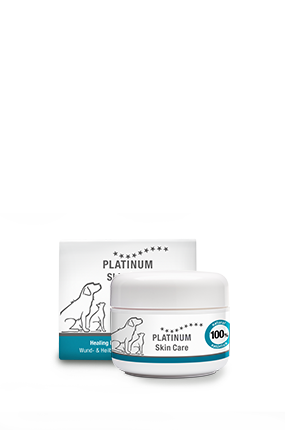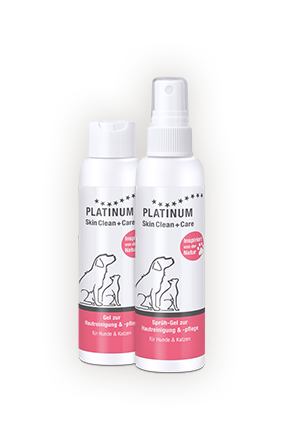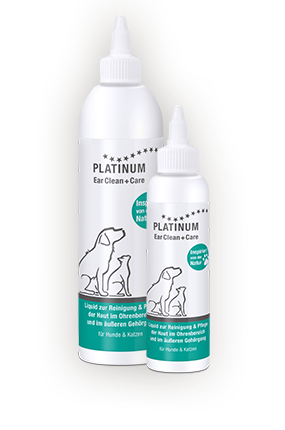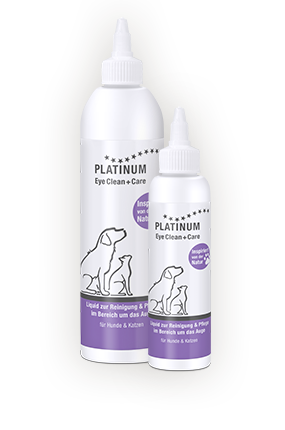Skin diseases in cats
Causes of skin diseases in cats
- Parasites (e.g. fleas, mites, ticks etc.)
- Skin fungus (e.g. impetigo or yeast infections)
- Bacterial infections
- Allergies due to food
- Environmental allergens (such as pollen, dust or mould)
- Incorrect diet or malnutrition
- Stress
- Side effect of other medicines
How do I recognise a skin disease in my cat?
- Skin irritation (e.g. scabbing, swelling or redness with pustules)
- Increased scratching due to itching
- Intensive licking of certain areas
- Change in the cat’s coat (shaggy coat)
- Severe hair loss leading to bald patches
- Increased rubbing, rolling or chafing
- Dry and flaky skin
- Chapped skin
- Change in odour
- Open areas or wounds that weep or bleed (increased risk of infection)
- Change in behaviour (nervousness or irritability)
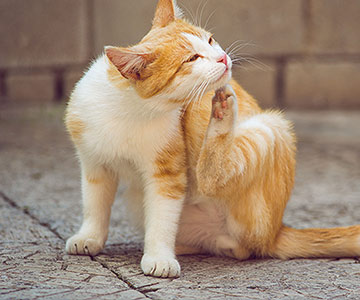 Intense scratching is a common sign of skin disease in cats
Intense scratching is a common sign of skin disease in cats
Diagnosis and treatment
A regular and thorough check of your cat’s skin and coat will serve to detect skin problems at an early stage. This is because parasites such as fleas and ticks can be easily recognised with a little practice. However, not everything can be seen by the naked eye, so you should always take your cat to the vet if one or more of the above symptoms occur. Your trusted vet not only has an expert eye, but also knows special diagnostic procedures. For example, a skin swab, skin scraping, biopsy or coat sample can be helpful in detecting pathogens such as skin fungi. Blood tests can be used to diagnose metabolic disorders or infections, and an allergy test can provide information if environmental allergies are suspected. The ears, an accessory organ of the skin, should also be checked regularly for abnormalities (such as redness, excessive secretion or injuries) and inspected by the vet if necessary.
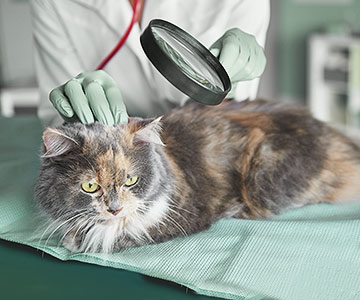 The vet examines the skin and coat for skin diseases in cats
The vet examines the skin and coat for skin diseases in cats
If the cat’s skin condition is due to a food allergy, an elimination diet can be followed to determine which ingredients are causing the allergy. Just as with external treatments or the administration of medication, a change in feed should take place only at a veterinarian’s instruction.
Prevention: What can I do to prevent skin diseases in cats?
Regular grooming is important to prevent skin diseases in cats. While cats do groom themselves and thus take over a large portion of coat care themselves, there are many reasons to support your feline friend in their grooming routine. We explain this in detail in our expert guide on the subject of coat care. While grooming, for example, you can use a brush to check your cat’s coat and skin effectively and precisely. This allows you to better detect the ectoparasites that live on the cat (e.g. fleas and ticks) and have these treated by your vet. Following a flea infestation, it is also recommended to worm your cat, as fleas can act as intermediate hosts for tapeworms. If the cat ingests the fleas through the mouth, the next parasitic infestation could be imminent and cause significant discomfort for the cat.
Depending on the cat’s living conditions, it may be advisable to administer a prophylactic agent to prevent ectoparasites following consultation with the vet. This can also help to prevent skin diseases.
You should also observe your pet’s behaviour, in order to detect changes early on. Behavioural changes in cats often indicate discomfort, which can be a sign of health problems.
Strengthening the skin flora with special care products also plays an important role in the prevention of skin diseases in cats.
Which skin diseases affect cats?
- Atopic dermatitis
- Feline acne
- Psychogenic lick alopecia due to stress
Allergic dermatitis in cats: Atopic dermatitis
- General itching
- Intensive licking (especially on the belly, inner thighs and paws)
- Fur falling out
- Redness, swelling, wounds
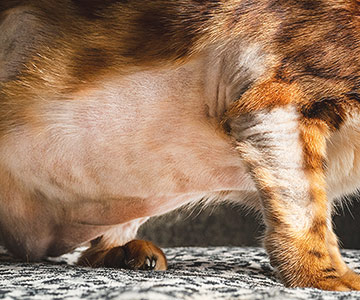 Atopic dermatitis in cats also manifests with hair loss on the abdomen
Atopic dermatitis in cats also manifests with hair loss on the abdomen
Acne in cats: Feline acne
- Blackheads, pimples and pustules mostly on the chin
- Head rubbing and scratching
- Sensitivity to pain in the affected areas
- Possible refusal of food as a result
- Fatigue
- Defensive behaviour
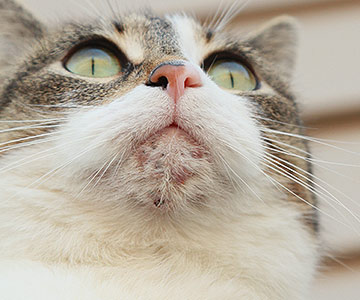 Feline acne usually occurs on the cat’s chin
Feline acne usually occurs on the cat’s chin
Skin diseases in cats due to stress: Psychogenic alopecia
- Intensive cleaning behaviour
- Bald patches in the coat that the cat can easily reach, such as the belly, paws or inner thighs
- There may be inflamed, oozing or bleeding spots, due to bacteria on the cat’s rough tongue
- Redness and swelling
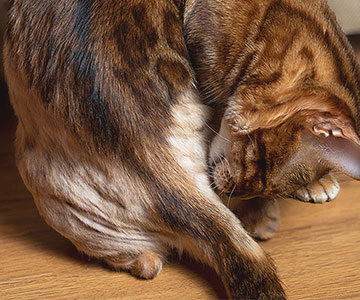 Coat loss in cats can also be caused by intense licking, caused by stress
Coat loss in cats can also be caused by intense licking, caused by stress
What does a fungal infection look like in a cat?
- Patchy hair loss on the face, ears or limbs (alopecia)
- Dry or oily skin
- Inflamed claws
- Inflammation of the hair follicles and/or the subcutaneous fatty tissue
- Coat can be easily pulled out at the edge of the localised change in skin
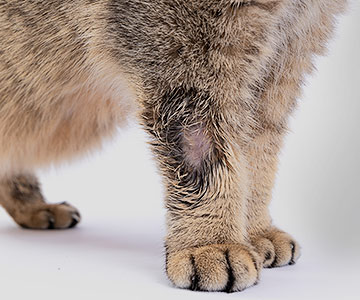 Feline fungal infection is a common skin disease in cats
Feline fungal infection is a common skin disease in cats
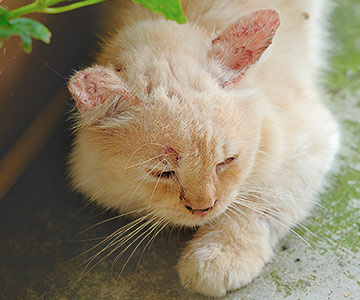 Hair loss usually occurs on the cat's face, ears or limbs
Hair loss usually occurs on the cat's face, ears or limbs
- Young kittens
- Cats with a weakened immune system or a skin injury (e.g. from parasites), as this allow fungal spores to enter the skin more easily
- Persian cats, due to a genetic predisposition
- Cats living in warm and humid regions (e.g. Mediterranean region)
- Stray or feral cats
- Cats that live together or that have contact with many other animals
What does mange look like in a cat?
- Hair loss in the area of the neck, head and ears
- Severe scratching in these areas
- Formation of yellowish-grey crusts, which also flake off
- Inflammation of the affected areas
- Frequent head shaking
- Tilting of the head and downturning of the ears
- Darkening of the ear surface
- Unpleasant odours
- Sores and crusts in the paw spaces
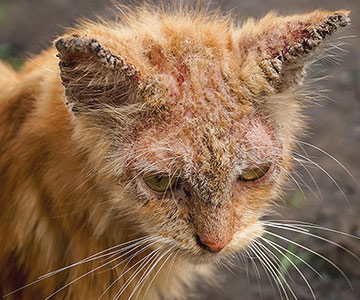 Mange is a highly contagious disease in cats
Mange is a highly contagious disease in cats
Mange is also highly contagious in cats, and does not only affect stray cats. Again, if you suspect mange, you should go straight to the vet.


 Deutsch
Deutsch
 English
English
 Nederlands
Nederlands
 Français
Français

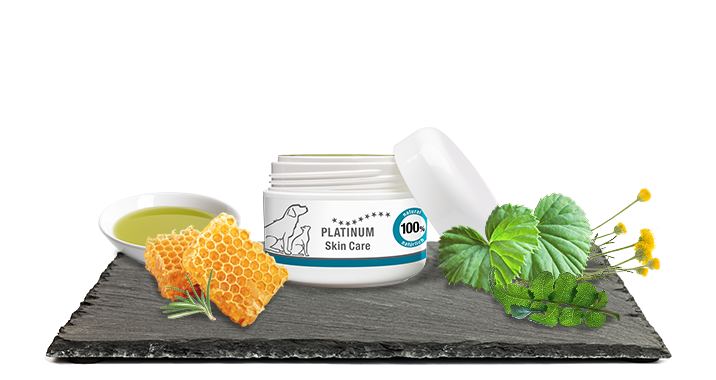
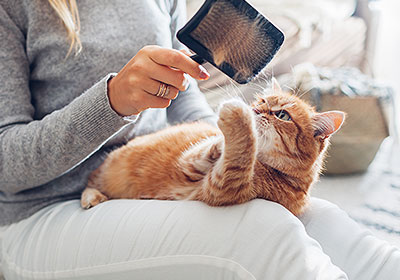
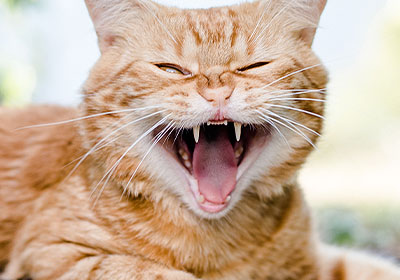
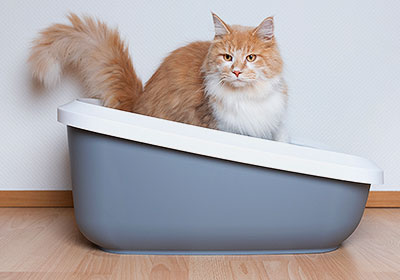
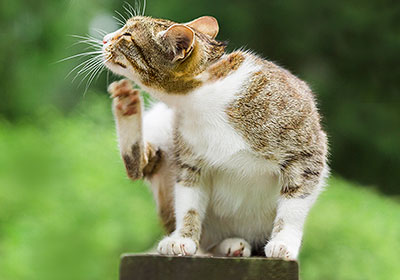
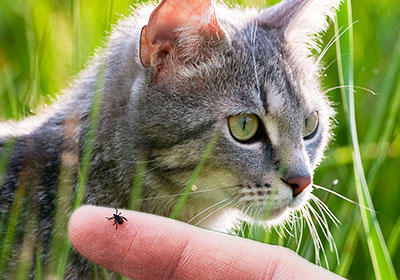
.png)
.png)
.png)
